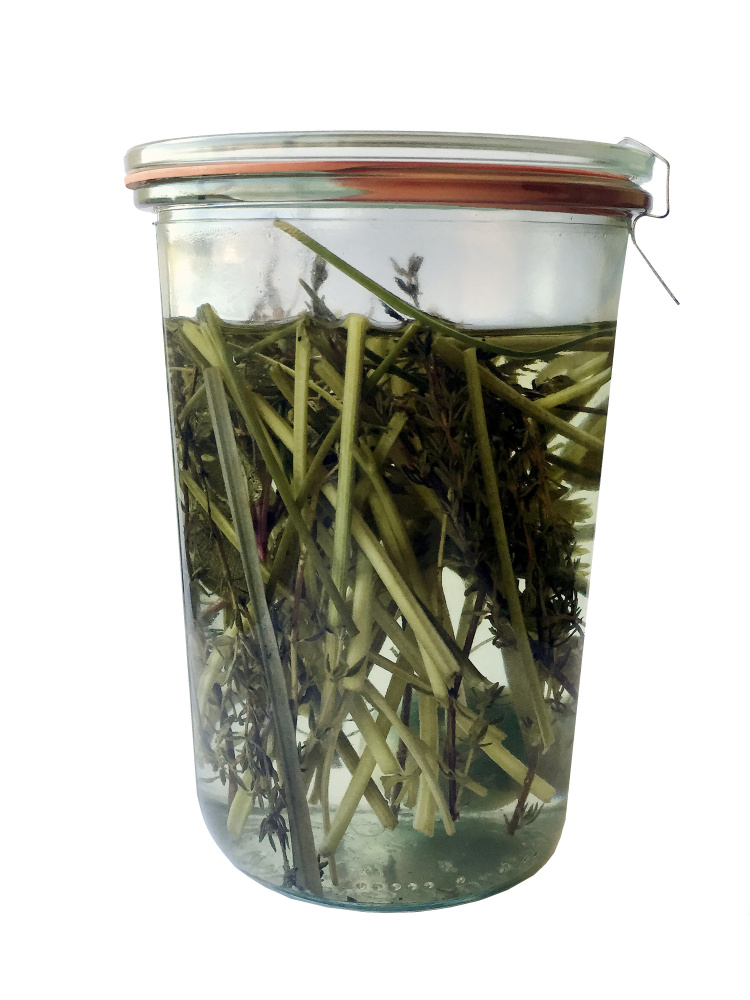If a living thing resides in my house but doesn’t audibly cry out for me to feed it, I generally forget to do so. Standing in line for sustenance behind two kids, a husband, a dog and a fish named Dumpling, the average life span of any plant placed in my care is about three months.
As a matter of personal growth, last spring I recycled three decrepit window boxes as the vessels for my first herb “garden.” I filled them with potting soil mixed with a little local compost and plants lovingly started at Kennebec Flower Farm. I put the herb boxes on the kitchen stoop where I knew rainwater cascading off the roof would feed them should the chore slip my mind.
I killed the rosemary. But I cooked all summer with the parsley, sage and thyme; was stunned by the rapid growth of the chives and mint and challenged to use them before they got leggy; and took several culinary adventures I would not have otherwise but for the lemongrass and lemon verbena in those boxes.
As the nights get colder and we start to weatherize the house and yard for the winter, I went looking for advice on how to properly preserve the herbs still left in the boxes for use this winter.
According to Betsy Williams, an herbalist and florist from Andover, Massachusetts, who was scheduled to give several presentations on herb preservation at the MOFGA Common Ground Fair this weekend, my options are many but somewhat dependent on the type of herb.
Williams’ go-to means of extending the influence of summertime herbs in her kitchen is to make flavored vinegars with them. By stuffing a jar full of an herb and a peeled clove of garlic, pouring any vinegar but distilled white (she saves that one for cleaning) over it, letting it sit for two to four weeks and then straining it, Williams makes vinegars from all types. Among her favorites are those made from basil flowers or chive blossoms. But her most interesting vinegars are those she makes over time with bits and pieces of herbs otherwise destined for the garbage (recipe below).
Williams also adds chopped herbs to store-bought mustard using a ratio of 2 tablespoons of fresh, finely chopped herbs to an 8-ounce jar. This will keep in the fridge for several months.
Herbs containing a lot of moisture like basil, parsley and cilantro are best frozen. Williams does not blanch these herbs before freezing, as is the fashion, particularly with basil, so as to keep the leaves bright green in the freezer. “Adding any heat to an herb volatizes its oils, and releases its flavors into the boiling water. At that point, you’re better off freezing the water as it’s got more basil flavor than the leaves do,” Williams said.
A better way to prep herbs for freezing is to grind them in a food processor into a paste with olive oil and pack them into ice cube trays. Once frozen, the herb cubes can be stirred into sauces, gravies and ordinary condiments to “upgrade your cooking all winter long,” says Williams.
Herbs with woody stems like thyme, rosemary, oregano, savory and mint are best dried. Tying them in bundles and hanging them above a wood stove or a vented refrigerator for several days does the trick. If neither of those is available, you can spread them out in a single layer on trays and place them in a very low oven (125 degrees) for about an hour. The trick to getting the most flavor from dried herbs is to crumble them just before using them, so Williams advises storing them whole in airtight glass jars where they will be good to use until next spring, when fresh herbs will be growing again in your garden.
MRS. THRIFT’S GARBAGE VINEGAR
Mrs. Thrift is a fictional neighbor through whom herbalist Betsy Williams conveys her message of sustainable herb usage in her book, “Mrs. Thrift Cooks by Putting Her Pantry to Use.” In this recipe, she takes bits and pieces of fresh herbs otherwise destined for the compost pile and uses them to make flavored vinegars that taste different each time.
Makes 3/4 cups vinegar
1 clean quart-sized canning jar with a new 2-piece lid
1 quart of good white wine vinegar
1 clove of garlic, peeled
Bits and pieces, odds and ends of fresh or dried kitchen herbs
Fill the jar with vinegar. Drop in the garlic and screw on the lid. Each time you use fresh or dried herbs in cooking, instead of throwing away or composting the leftover pieces, put them in the jar. The stems and flowers of culinary herbs infuse the vinegar with flavor and fragrance. When the jar is completely full of leftover herbs, let it sit for a week. Strain the herb vinegar through a clean dishtowel or several layers of cheese cloth. Pour it into a clean bottle. Cap tightly. Use frequently.
Christine Burns Rudalevige is a food writer, recipe developer and tester, and cooking teacher in Brunswick. She writes about feeding her family Maine seafood at www.familyfish.net. Contact her at cburns1227@gmail.com.
Send questions/comments to the editors.



Success. Please wait for the page to reload. If the page does not reload within 5 seconds, please refresh the page.
Enter your email and password to access comments.
Hi, to comment on stories you must . This profile is in addition to your subscription and website login.
Already have a commenting profile? .
Invalid username/password.
Please check your email to confirm and complete your registration.
Only subscribers are eligible to post comments. Please subscribe or login first for digital access. Here’s why.
Use the form below to reset your password. When you've submitted your account email, we will send an email with a reset code.